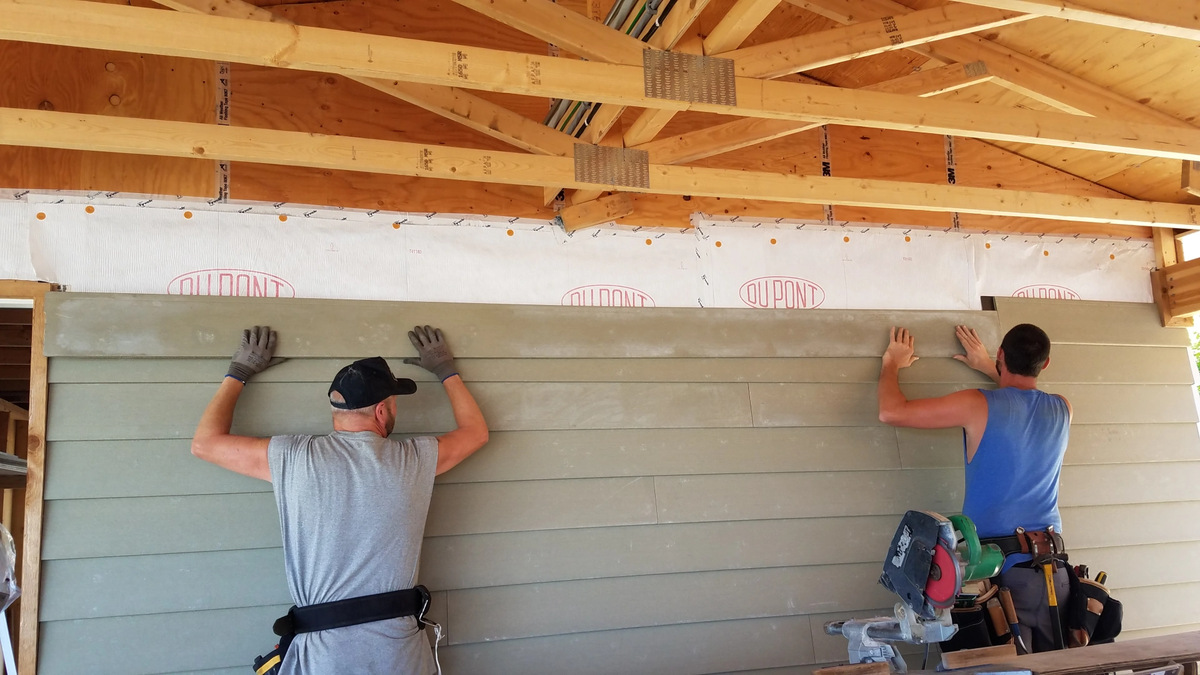Home>Garden Essentials>How To Write A Bid For Landscaping


Garden Essentials
How To Write A Bid For Landscaping
Modified: March 7, 2024
Learn how to write a winning bid for landscaping projects, with a focus on creating stunning gardens. Master the art of persuasive proposals and stand out from the competition.
(Many of the links in this article redirect to a specific reviewed product. Your purchase of these products through affiliate links helps to generate commission for Storables.com, at no extra cost. Learn more)
Introduction
Welcome to the world of landscaping! Whether you are a seasoned professional or just starting out, writing a bid for landscaping services is an essential skill that can make or break your success in the industry. In this article, we will guide you through the process of crafting a comprehensive and engaging bid that will impress your potential clients and help you win the project.
Writing a successful bid requires a blend of creativity, industry knowledge, and a thorough understanding of your client’s needs. It’s not just about providing a price; it’s about showcasing your expertise, presenting a compelling case for why your services are the best fit for the project, and building trust with your potential clients.
In the following sections, we will go through the key steps to writing a bid for landscaping. From understanding the requirements and researching the project to crafting a compelling cover letter and providing a detailed scope of work, we will cover all the important aspects that will elevate your bid and set you apart from the competition.
Before we dive into the specifics, it’s important to note that each bid should be tailored to the specific project and client. While you may have templates or a general structure for your bids, make sure to customize each one to highlight the unique aspects of the project and address the client’s specific needs and concerns.
So, whether you’re bidding on a small residential garden project or a large commercial landscaping job, let’s explore the steps to writing a winning bid that will leave a lasting impression on your potential clients.
Key Takeaways:
- Crafting a winning bid for landscaping involves understanding client needs, showcasing expertise, and addressing concerns. Tailor each bid to stand out and build trust with potential clients.
- A successful bid for landscaping services requires creativity, industry knowledge, and personalized communication. Tailor each bid to showcase expertise and address client needs.
Read more: How To Bid On Landscaping Jobs
Understanding the Requirements
One of the first and most crucial steps in writing a bid for landscaping services is gaining a clear understanding of the client’s requirements. This involves more than just knowing the size of the area to be landscaped; it also requires getting a complete picture of the client’s vision, preferences, and budget.
Start by scheduling a face-to-face meeting or a phone call with the client to discuss their landscaping needs in detail. During this conversation, ask open-ended questions to prompt the client to share their ideas, expectations, and any specific features or elements they want to incorporate in their landscape design.
It’s important to actively listen and take notes during this conversation. Pay attention to the client’s preferences on plants, colors, styles, and any unique features they may desire. By understanding and capturing these details, you will be able to create a bid that aligns with the client’s vision and stands out from other generic proposals.
In addition to understanding the client’s aesthetic preferences, it’s equally important to address practical considerations. Are there any specific environmental or maintenance concerns you need to take into account? Is the area prone to any challenging soil conditions or drainage issues? Understanding these factors will help you determine the scope of work and any additional services or expertise you may need to provide.
During this phase, it’s also essential to discuss the client’s budget. While some clients may have a specific budget in mind, others may be open to various options. Understanding their financial constraints will enable you to propose solutions that meet their budget while still delivering high-quality results. Keep in mind that providing flexibility and options can also make your bid more appealing to clients.
Once you have gathered all the necessary information, take the time to review and organize it. This will guide you in crafting a tailored bid that addresses all the client’s requirements and showcases your understanding of their vision.
With a clear understanding of the client’s requirements, you’re ready to move on to the next step: researching the project.
Researching the Project
Researching the project is a crucial step in the bid writing process. It allows you to gather valuable information about the site, identify any potential constraints or challenges, and showcase your knowledge and expertise to the client.
Start by conducting a site visit. This will give you a firsthand understanding of the location and its unique characteristics. Take note of the topography, soil type, existing vegetation, and any other relevant factors that may impact the design and implementation of the landscaping project.
During the site visit, observe the lighting conditions and assess the potential for shade or sunlight exposure. This will help you make informed decisions about the types of plants and landscaping features that will thrive in the area.
If possible, take photographs and measurements of the site. These visual references will be valuable when putting together your bid and can give you a better sense of how to plan and layout the landscaping elements.
In addition to the physical site visit, take the time to research any local regulations or permits that may be required for the project. This could include restrictions on tree removal, water usage, or the installation of certain landscaping features. Being knowledgeable about these regulations can show your professionalism and help you provide accurate information to the client.
Furthermore, conduct research on the latest trends and best practices in landscaping design and maintenance. Stay up to date with industry publications, attend conferences or seminars, and engage in online forums or communities to gather valuable insights and ideas. This research will not only enhance your own skill set but also allow you to offer innovative and contemporary solutions to the client.
Finally, take the time to research your competition. Look into other landscaping companies or professionals who have worked on similar projects in the area. This will help you understand the market landscape, identify potential gaps or opportunities, and position your bid in a way that highlights your unique selling points.
By conducting thorough research, you will be equipped with the knowledge and information needed to create a well-informed and competitive bid. The next step in the process is crafting a compelling cover letter that captures the client’s attention and introduces your bid.
Crafting a Compelling Cover Letter
A well-crafted cover letter is your opportunity to make a strong first impression and grab the attention of your potential client. It sets the tone for your bid and showcases your professionalism, expertise, and enthusiasm for the project. Here are some tips for writing a compelling cover letter:
- Personalize the letter: Begin by addressing the client by name and briefly mention your previous interaction or conversation. This shows that you have taken the time to understand their needs and establishes a personal connection.
- Highlight your strengths: In the opening paragraph, highlight your key strengths and qualifications that make you the ideal candidate for the project. Showcase your experience, relevant certifications, and any specialized skills that set you apart from other landscapers.
- Showcase your understanding of the project: Demonstrate your knowledge of the client’s requirements and vision by summarizing the key points discussed during your initial meeting or conversation. This shows that you have paid attention and are committed to delivering a solution that aligns with their expectations.
- Share your creative ideas: Use the cover letter as an opportunity to briefly present some innovative and unique ideas that you have for the project. This will demonstrate your creativity and strategic thinking, and it will give the client a glimpse of the value you can bring to their landscaping project.
- Address potential concerns: If you anticipate any potential concerns or challenges that may arise during the project, address them in your cover letter. Assure the client that you have experience in handling similar situations and emphasize your problem-solving skills.
- Show appreciation and enthusiasm: Close the cover letter by expressing your gratitude for the opportunity to bid on the project and convey your genuine enthusiasm for the project. Emphasize your commitment to delivering high-quality work and building a long-term relationship with the client.
Remember to keep the cover letter concise and focused. Aim for a balance between professionalism and personalized warmth. Proofread the letter multiple times to ensure it is free of grammatical and spelling errors.
By crafting a compelling cover letter, you can make a strong impression on the client, demonstrate your understanding of the project, and set the stage for a successful bid presentation. The next step in the process is providing a detailed scope of work in your bid.
Providing a Detailed Scope of Work
When writing a bid for landscaping services, it is crucial to provide a detailed scope of work that outlines the specific tasks and deliverables you will provide to the client. This not only sets clear expectations but also demonstrates your professionalism and attention to detail. Here are some key points to consider when outlining the scope of work:
- Start with an overview: Begin by providing a brief overview of the project, including the location, size of the area to be landscaped, and any other relevant details. This helps the client understand the context of your proposal.
- Break down the tasks: Clearly outline the specific tasks and activities that will be included in the project. This can include site preparation, planting, hardscaping, irrigation system installation, maintenance, and any other services you will provide.
- Specify materials and plants: Detail the types of materials, plants, and equipment that will be used in the project. This demonstrates your expertise and allows the client to understand the quality and aesthetic of the final result.
- Explain the process: Provide a step-by-step explanation of how you will execute the project. This includes any necessary site preparation, the order of tasks, and an estimated timeline for completion.
- Include maintenance: If ongoing maintenance is part of the project, outline the specific services you will provide, such as lawn care, irrigation system monitoring, pruning, and weed control.
- Address customization: If the client has requested any specific features or customization, explain how you will incorporate these into the project. Include any additional costs or time requirements associated with these requests.
- Highlight warranties and guarantees: If applicable, specify any warranties or guarantees you provide for the work and materials. This reassures the client that you stand behind your work and instills confidence in your capabilities.
- Outline potential additional services: If there are any optional or additional services that the client may want to consider, such as landscape lighting or ongoing maintenance packages, mention them briefly and provide separate pricing if applicable.
Remember to use clear and concise language in your scope of work. Avoid technical jargon and explain any industry-specific terms to ensure the client fully understands the details of your proposal.
By providing a detailed scope of work, you demonstrate your expertise, set clear expectations, and showcase your commitment to delivering a high-quality landscaping project. The next step is to present a competitive pricing strategy in your bid.
When writing a bid for landscaping, be sure to include a detailed description of the work to be done, a breakdown of costs, and any relevant experience or qualifications.
Read more: How To Write A Landscaping Estimate
Presenting a Competitive Pricing Strategy
When submitting a bid for landscaping services, it’s important to present a competitive pricing strategy that reflects the value you offer while remaining attractive to the client. Here are some key considerations when determining your pricing strategy:
- Evaluate the project complexity: Assess the complexity of the landscaping project, including factors such as the size of the area, the type and quantity of materials required, and the level of customization or detail involved. Take into account any unique challenges or specialized expertise that may be required.
- Consider labor and equipment costs: Calculate the labor costs by estimating the number of hours it will take to complete the project, factoring in the expertise and experience of your team. Also, account for any equipment and machinery rental or maintenance expenses that will be necessary for the project.
- Include material costs: Research and estimate the costs of materials needed for the project, taking into account pricing fluctuations and variations in quality. Consider any discounts or supplier relationships that may allow you to offer competitive prices without compromising on quality.
- Account for overhead and profit margins: Factor in your overhead costs, including administrative expenses, insurance, and other operational costs. Be sure to include an appropriate profit margin that reflects the value you bring to the project and ensures the sustainability and growth of your business.
- Be transparent and itemize costs: Clearly outline the pricing breakdown in your bid. Itemize each cost—whether it’s labor, materials, or equipment—so that the client can understand and compare your bid with others they may receive.
- Consider pricing alternatives: Offer different pricing options to the client, such as a basic package and an enhanced package with additional features or services. This allows the client to choose the option that best meets their needs and budget.
- Competitive research: Conduct research on the pricing strategies of your competitors, taking into account their reputation, experience, and the quality of their work. Price your services competitively while highlighting the unique value and expertise you bring to the project.
- Emphasize long-term value: Explain the long-term value and return on investment that the client will receive by choosing your services. Highlight the durability of materials, the quality of craftsmanship, and the professional maintenance and support you provide.
It’s important to strike a balance between offering competitive prices and ensuring that your bid covers all the costs associated with the project. Remember that undercutting your competitors significantly may raise doubts about the quality or completeness of your services.
By presenting a well-considered and competitive pricing strategy, you demonstrate your professionalism, value, and commitment to delivering excellent results. The next step is to highlight your relevant experience and credentials in your bid.
Highlighting Relevant Experience and Credentials
When writing a bid for landscaping services, it’s important to showcase your relevant experience and credentials to instill confidence in the client and differentiate yourself from competitors. By highlighting your expertise and track record of successful projects, you can demonstrate your capability to deliver quality results. Here are some key points to include:
- Provide an overview of your company: Introduce your company and provide a brief overview of your background, including the number of years in business, your mission, and core values. This helps establish credibility and professionalism right from the start.
- Showcase past projects: Highlight previous landscaping projects that are similar in scope or style to the current project. Include descriptions, photographs, or references to demonstrate the quality of your work and the satisfaction of previous clients.
- Emphasize specialized expertise: If you have particular expertise in a specific type of landscaping design, such as garden renovations, sustainable landscaping, or urban rooftop gardens, make sure to emphasize this. This sets you apart from competitors and positions you as a trusted authority in the field.
- Highlight certifications and qualifications: List any relevant certifications or qualifications that you or your team possess, such as landscape architecture degrees, horticultural certifications, or licenses. These credentials show your commitment to professional development and adherence to industry standards.
- Show evidence of client satisfaction: Include testimonials or case studies from satisfied clients who can speak to the quality, reliability, and professionalism of your services. This social proof helps build trust with potential clients and reinforces your reputation.
- Discuss ongoing professional development: Mention any industry conferences, workshops, or training programs that you or your team regularly attend to stay up to date with the latest trends and techniques in the field. This shows your commitment to continuous improvement and delivering cutting-edge solutions.
- Highlight awards and recognitions: If you or your company has received any awards or recognition within the landscaping industry, be sure to mention them. This establishes you as a trusted and respected player in the field.
When highlighting your experience and credentials, focus on the aspects that are most relevant to the client’s project. Tailor your presentation to address any specific concerns or requirements they have communicated to ensure that you stand out as the best fit for the job.
By showcasing your relevant experience, qualifications, and satisfied clients, you will build trust with potential clients and increase your chances of winning the landscaping project. The next step is to include a timetable and milestones in your bid, outlining the project timeline.
Including a Timetable and Milestones
When writing a bid for landscaping services, including a clear timetable and milestones is essential to demonstrate your organization and project management skills. It allows the client to visualize the timeline of the project and understand the key milestones along the way. Here are some important points to consider when outlining the project timeline:
- Breakdown the project into phases: Divide the project into distinct phases, such as site preparation, design development, installation, and maintenance. This helps the client understand the sequential flow of the project and what to expect at each stage.
- Assign specific durations for each phase: Estimate the time required for each phase based on your experience and the scope of work. Be realistic in your estimates to ensure that you can deliver on schedule without compromising on quality.
- Specify start and end dates: Provide specific start and end dates for each phase to give the client a clear understanding of the overall project timeline. This helps manage their expectations and ensures that both parties are aligned on the project’s schedule.
- Identify key milestones: Highlight important milestones within each phase, such as the completion of site preparation, the finalization of the design concept, or the installation of specific landscaping features. These milestones act as checkpoints and show progress to the client.
- Include contingency time: Account for potential delays or unforeseen circumstances by incorporating contingency time into the project timeline. This demonstrates your preparedness for unexpected challenges and helps maintain a realistic project schedule.
- Communicate the availability of your team: If there are any periods when your team or specific subcontractors may not be available or when work will be paused (e.g., during vacations or holidays), clearly communicate this to avoid misunderstandings.
- Collaborate with the client: Seek input from the client on their preferred timing for the project. Consider any specific deadlines or events that may impact the schedule. Collaboration improves project management and client satisfaction.
- Offer regular progress updates: Assure the client that you will provide periodic progress updates throughout the project, so they are aware of the milestones achieved and any adjustments to the timeline if necessary. This helps build trust and maintains open communication.
Including a detailed timetable and milestones in your bid demonstrates your commitment to timeline management and allows the client to visualize the progress and completion of the project. It also provides a foundation for effective project planning and coordination.
With the timetable and milestones included in your bid, you can now move on to the next step: addressing potential concerns and risks.
Addressing Potential Concerns and Risks
When writing a bid for landscaping services, it’s important to address potential concerns and risks upfront to instill confidence in the client and demonstrate your ability to mitigate and manage potential challenges. By proactively acknowledging and addressing these concerns, you build trust and demonstrate your commitment to delivering a successful project. Here are some key points to consider when addressing potential concerns and risks:
- Identify potential challenges: Assess the project requirements and site conditions to identify any potential challenges that may arise during the landscaping process. This could include issues such as soil erosion, drainage problems, or adverse weather conditions.
- Expound on your problem-solving approach: Clearly explain how you will address these challenges and provide solutions. Showcase your expertise in handling similar situations in the past and highlight the steps you will take to mitigate risks and ensure the success of the project.
- Communicate openly about potential limitations: If there are any limitations or constraints that may impact the project, be transparent and communicate them to the client. This can include factors such as budget constraints, time constraints, or access limitations to the site. Detail how you plan to work within these limitations to still achieve the desired outcomes.
- Offer alternative solutions: Present alternative options or strategies that can help alleviate concerns or mitigate potential risks. This shows your flexibility and creativity in finding solutions and demonstrates your commitment to meeting the client’s needs.
- Provide references and testimonials: Share testimonials or references from previous clients who have faced similar concerns or challenges. This allows the client to hear firsthand experiences and success stories, providing them with reassurance.
- Mention insurance coverage: Highlight that your company holds a comprehensive insurance policy to protect both the client and your team during the project. This gives the client peace of mind knowing that they will not be held liable in the case of any unforeseen accidents or damages.
- Discuss change management: Outline your approach to handling potential changes or modifications to the project scope. Assure the client that you will communicate any proposed changes promptly and involve them in decision-making to avoid misunderstandings or disputes.
- Address communication and collaboration: Emphasize your commitment to maintaining open lines of communication with the client throughout the project. Highlight how you will provide regular updates, share progress reports, and promptly address any concerns or queries they may have.
By proactively addressing potential concerns and risks, you demonstrate your professionalism, transparency, and commitment to a successful outcome. This builds trust with the client and increases their confidence in choosing you as their landscaping service provider.
With potential concerns and risks properly addressed, you can now conclude your bid. In the next section, we will wrap up the article with a concluding paragraph.
Read more: How To Write Up A Landscaping Contract
Conclusion
Writing a comprehensive and engaging bid for landscaping services is a crucial step in securing new projects and showcasing your expertise in the industry. By following the steps outlined in this article, you can elevate your bids and increase your chances of success. From understanding the client’s requirements and researching the project to crafting a compelling cover letter and providing a detailed scope of work, each aspect plays a critical role in winning over potential clients. Additionally, highlighting your relevant experience and credentials, presenting a competitive pricing strategy, and addressing potential concerns and risks are key elements that demonstrate your professionalism and commitment to delivering quality results.
Remember, each bid should be tailored to the specific project and client, showcasing your unique strengths and addressing their specific needs. By infusing creativity, industry knowledge, and a human touch in your writing, you can engage potential clients and make your bid stand out from the competition. Moreover, effective communication, timeliness, and transparency throughout the bidding process are essential to foster trust and build strong relationships with your clients.
As you embark on your bid writing journey, always strive for excellence, continuously refine your skills, and stay up to date with the latest landscaping trends and practices. With a winning bid, you can secure exciting new projects, exceed client expectations, and grow your reputation in the world of landscaping.
Now, armed with these valuable insights, it’s time for you to confidently write compelling bids and embark on a successful journey in the landscaping industry.
Frequently Asked Questions about How To Write A Bid For Landscaping
Was this page helpful?
At Storables.com, we guarantee accurate and reliable information. Our content, validated by Expert Board Contributors, is crafted following stringent Editorial Policies. We're committed to providing you with well-researched, expert-backed insights for all your informational needs.














0 thoughts on “How To Write A Bid For Landscaping”